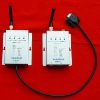- Contact Person : Ms. Bai Ling
- Company Name : FOURSTAR Electronic Technology Co., Ltd. (Deyang China)
- Tel : 0086-838-2515543
- Fax : 0086-838-2515546
- Address : Sichuan,DeYang,The second floor of Building H, century garden, NO.88 of Section 2 of Lushan South Road,
- Country/Region : China
- Zip : 618000
Model:FS-PBHUB-6, Isolated PROFIBUS/MPI/PPI repeater
I. Basic Features of PROFIBUS
RS485 interface technique is used in the physical layer of Fieldbus PROFIBUS, which is the most common way in application. It is hard for RS485 Network to maintain rather high reliability and stabilization when the rate of data signaling reaches as high as 12MbpS. Hence, further strict definition and supplement for RS485 technique are added to PROFIBUS Standards, including concepts like network topology, segment, terminal, repeat, branch, etc. Besides, detailed technical specifications are given about the used network components, such as cables, connectors, repeaters, etc.
As regulated in PROFIBUS Standards, bus network topology is adopted when RS485 is signaled. Network components like repeater and connector, and concepts like network segment, terminal, etc, are also presented in the Standards. As shown in Fig. 1-1, the repeater cuts the bus into Segment 1 and Segment 2, and the head and end of each segment are called terminals.
2. Terminal resistor has to be set at two terminal stations of each PROFIBUS network segment, and the power is never off at the two stations during network operation (if there's no uninterrupted power, an active terminal resistor with uninterrupted power has to be installed at the terminal. The active terminal resistor produced by Fourstar is Mode PB-TR485.) Set terminal resistor at terminal stations means moving the switch of terminal resistor in the bus connector plug of PROFIBUS to ON, while switches in other stations' bus connector plugs have to be moved to OFF. So, it is crucial to determine which station is the segment's terminal.
3. Logically, PROFIBUS Standards regulates that the number of stations can be 126 (station address 0~125 can be used in general master/Slave Station). No more than 32 stations can appear in one PROFIBUS network segment. If more than 32 stations are needed to be connected to PFOFIBUS bus, such devices as repeaters or hubs are required to amplify the bus into several segments.
4. The communication media for PROFIBUS has to be the special cable that meets the PROFIBUS Standards (Siemens Product No. 6XV1 830-0EH10). Such cable has the following features as shown in Table 1-1:
Table 1-1 Features of Special Cables for PROFIBUS
General Features | Specification |
Type | Shielded Twisted-Pair |
Cross Section Area of Conductor | 24AWG(0.35mm2)or thicker |
Cable Capacitance | <60pf/m |
Characteristic Impedance | 100Ω~120Ω |
The max length of the communication cable in each PROFIBUS network segment is closely related to the baud rate, as shown in the following Table 1-2. The max transmission rate of the whole PROFIBUS network depends on the network segment which has the longest cable.
Table 1-2 Max. Cable Length of A PROFIBUS Segment under Different Transmission Rate
Transmission Rate (bit/s) | 9.6K | 19.2K | 45.45K | 93.75K | 187.5K | 500K | 1.5M | 3M | 6M | 12M |
Max. Cable Length (Meter) | 1200 | 1000 | 400 | 200 | 100 | |||||
II. Main Applications and Features of PROFIBUS Hub
PROFIBUS Hub has following major applications:
1. Functions of a hub: change PROFIBUS network bus topology structure to achieve star and hybrid network structure and facilitate wiring. It is very convenient to use special PROFIBUS cables and plugs to achieve bus connection among stations (see Fig. 1-1), but it is difficult to achieve the network requirement of PROFIBUS star and hybrid topology structure. PROFIBUS Hub can facilitate the materialization of PROFIBUS star and hybrid topology structure. See Fig. 2-1.
2. Functions of the repeater: each interface of PROFIBUS Hub serves as a Repeater interface, which can drive one PROFIBUS network segment respectively, which means another 31 station interfaces can be connected, and the max transmission distance under corresponding transmission rate can be prolonged. Moreover, cascade connection can also be realized. Consequently, PROFIBUS network of mixed pattern is constituted through the hub, and the stations can be as many as 126. The transmission distance can be as long as several kilometers based on the number of cascade connection (related to the used transmission baud rate).
3. Functions of the isolator: Each interface of PROFIBUS Hub can be extended into a "PROFIBUS segment" (can be called "segment interface"). Electrical isolation exists between each interface segment, which means the segment is isolated from each other. Such conditions are necessary for protecting interface, interference suppression, and improving the network system's stabilization.
4. Monitor and diagnose: Through the LED indicator on PROFIBUS Repeater, one can monitor the working condition of PROFIBUS network and provide references for network diagnostic and troubleshooting.
FOURSTAR PROFIBUS Hub has following features:
1. Transparent transmission in the physical layer: PROFIBUS Hub adopts bit transparent transmission in the physical layer, having nothing to do with the upper-layer protocol. So it is applicable to all PROFIBUS protocols based on RS485, including PROFIBUS-DP/V0, V1, V2, and various application rules including PROFIsafe, Redundancy, and Ident Systems, etc. It is able to connect to multi master stationfor communication, such as S7 FUNCTION Protocol, secondary-type Master Station communication; it is also applicable to MPI Protocol, PPI Protocol, RS485 Free Port Protocol, and other fieldbus or network, such as MODBUS.
*Transport mode:Air.
*Technical support : fourstar-dy.com
*Factory direct sale, support online sale.
Model:FS-PBHUB-6, Isolated PROFIBUS/MPI/PPI repeater










